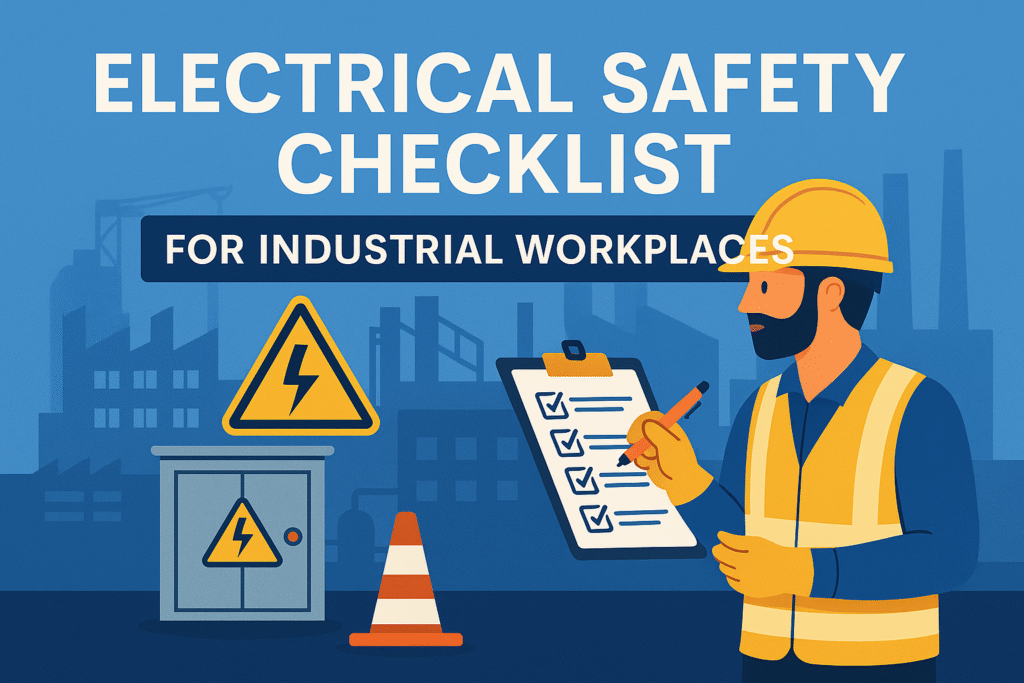
Electrical Safety Checklist for Industrial Workplaces
Industrial workplaces rely heavily on electrical systems to power machines, tools, and equipment. However, electrical hazards such as shocks, arc flashes, fires, faulty wiring, and unsafe equipment remain major causes of workplace injuries and fatalities.
A well-structured electrical safety checklist helps supervisors, electricians, and safety officers systematically identify hazards, ensure compliance, and maintain safe working conditions. This article provides a complete, easy-to-use checklist tailored for manufacturing, factories, warehouses, and heavy industrial sites.
Electrical Safety Checklist for Industrial Workplaces
Use this checklist daily, weekly, or during scheduled audits to ensure safe electrical operations.
1. General Electrical Installation Safety
Wiring & Panels
- No exposed wires or live conductors
- All electrical panels are labeled and secured
- Panel doors can close properly
- No water leakage near panels
- Circuit directories are updated
- No combustible material stored near panels
- Access to panels is clear (minimum 1-meter clearance)
Conduits & Cable Routing
- Cables routed through proper conduits
- No sharp bends damaging insulation
- Cables are free from abrasion, cuts, or frays
- Overhead and floor cables protected against mechanical damage
2. Equipment & Machinery Safety
Inspection of Tools & Machines
- All equipment is properly grounded
- Warning labels and nameplates visible
- Machines shut down properly during non-operation
- No overheating or burning smell
- Guards and covers in place for electrical parts
Portable Electrical Tools
- No damaged plugs or cracked insulation
- Tools have intact grounding pins
- Cable joints are not taped or makeshift
- Tools are inspected before each use
3. Switches, Cords, and Plugs
General Checks
- Switches and plugs operating smoothly
- No loose connections
- Plugs fit tightly into sockets
- No overloaded multi-plug adaptors
- No exposed conductive parts
Extension Cords
- Heavy-duty, industrial-rated
- Not run across high-traffic paths
- Not used as permanent wiring
- Free from cuts, twists, or heating
4. Electrical Panels & Distribution Boards
Visual Inspection
- Main breakers free from dust and corrosion
- Proper labeling and identification of circuits
- No signs of arcing or burning marks
- Breakers not frequently tripping (sign of overload)
Safety Features
- Lockable doors
- Insulated busbars
- Functional earthing/grounding
- Phase separators present
5. Grounding and Earthing System
Grounding Checks
- All machines properly grounded
- Earthing pits are maintained and tested annually
- Earth resistance values within acceptable limits
- No broken earth wires or disconnected links
Bonding
- Bonding conductors intact
- Metallic parts bonded to prevent static buildup
6. Residual Current Devices (RCDs) & GFCIs
Inspection Checklist
- RCD/GFCI installed where required (wet areas, outdoor use)
- Test button functional
- Sensitivity within required rating (30 mA for personnel protection)
- No bypassing of protection devices
7. Lockout/Tagout (LOTO) Compliance
Before Maintenance
- Written LOTO procedure in place
- Authorized personnel only
- Equipment properly de-energized
- Locks and tags applied individually
During Maintenance
- Residual energy discharged
- Lock keys controlled by authorized personnel
- Verification performed before starting work
After Maintenance
- LOTO removed only by the person who applied it
- System tested and energized safely
8. Electrical Hazard Identification
Common Hazards
- Exposed conductive parts
- Overloaded circuits
- Wet areas near electrical equipment
- Sparks, unusual noise, burning smell
- Unauthorized use of temporary wiring
Controls
- Barricading high-voltage areas
- Warning signage
- Immediate reporting and isolation
9. Personal Protective Equipment (PPE) for Electrical Work
Required PPE
- Insulated gloves
- FR (Flame Resistant) clothing
- Safety shoes (electrical hazard rated)
- Arc-rated face shield
- Safety goggles
- Insulated mats
Usage Checks
- PPE inspected for tears and damage
- Correct voltage rating used
- PPE cleaned and dry before use
10. Safe Work Practices
General Rules
- No wet hands near electrical systems
- Do not bypass safety devices
- Avoid metal ladders during electrical work
- Maintain safe clearance from live lines
- Follow permit-to-work procedures
11. Emergency Preparedness
Fire & Emergency Equipment
- Class C fire extinguishers available
- Emergency shutdown switches accessible
- First-aid kits stocked
- Trained personnel available for electrical emergencies
Emergency Response
- Power cut-off procedures clearly posted
- Emergency contact numbers displayed
- Fire alarms and smoke detectors operational
12. Documentation & Records
Required Documents
- Electrical inspection logs
- Preventive maintenance records
- LOTO training certificates
- Grounding/earthing test reports
- Incident and near-miss reports
- Equipment manuals and safety data sheets
Proper documentation ensures regulatory compliance and continuous improvement.
Conclusion
Electrical safety in industrial workplaces is essential for preventing shocks, arc flashes, fires, and equipment failures. This checklist helps ensure that electrical installations, machinery, tools, PPE, and work practices meet safety standards and regulatory requirements. By following this checklist regularly, organizations can create a safer working environment and reduce electrical risks significantly.
Electrical safety is not just a rule — it’s a responsibility shared by everyone on site.
For more checklist and templates visit The HSE Tools.
Lockout/Tagout LOTO Procedures for Electrical Maintenance
What Is a Residual Current Device (RCD) and How It Works
Understanding the Concept of Earthing and Grounding
Electrical Hazards and Their Control Measures
Static Electricity Hazards in the Workplace
Frequently Asked Questions (FAQs)
1. How often should electrical inspections be conducted?
Daily visual checks and detailed inspections monthly or quarterly.
2. Who can perform electrical maintenance?
Only trained, competent, and authorized electricians.
3. What is the most common cause of electrical fires?
Overloaded circuits and faulty wiring.
4. Why is grounding important?
It prevents electric shock by providing a safe path for fault currents.
5. What is essential PPE for electrical work?
Insulated gloves, FR clothing, dielectric boots, and arc-rated face shields.